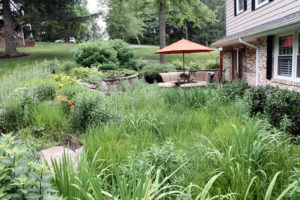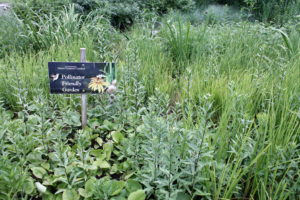Full and Fuller
May 31st, 2022
I’ve seen a big shift these last few years in what gardeners view as the “best,” or at least the “desired,” way to garden.

Naturalistic gardens like this back-yard one in York County are trendy lately.
The trend is strongly toward a natural look in which lots of different plants intermingle and grow in laissez-faire masses – similar to how plants grow in the wild.
That’s in contrast to the more formal, tended look that’s been the landscape norm for decades. In that style, order reigns supreme, and every plant has its space… with a neat carpet of mulch underneath and between.
Whether you call it a meadow or a cottage garden or a naturalistic landscape, the loosely regulated, action-packed look has the common thread of a tremendously full planting.
Bare soil doesn’t show its face in these gardens – at least not during the growing season.
Traditional spacing guidelines are out the window, replaced by packing as much in as possible and letting self-seeding fill in the rest.
So much is going on in these gardens that they’re season-long riots of color and texture.
Several factors are converging to fuel this “new naturalism,” as author Kelly Norris calls it.
One is the message about helping pollinators. Concerned about the plight of bees and butterflies, many gardeners are acting on the petition of popular authors like Dr. Doug Tallamy, Rick Darke, Thomas Rainer, Claudia West, Piet Oudolf, Larry Weaner and others to plant not just for cosmetics but with an eye on benefiting ecosystems and the wildlife in it.
Related to that is the boom in native plants, which is being fed by concerns of invasive plants bumping out native species that local wildlife needs to survive.
And a third factor is that people are tired of spraying, trimming, mulching, and mowing big lawns. They see the loose approach as less work and welcome the idea of yards that are better able to care for themselves.
These tightly-packed, naturalistic gardens deliver on a variety of fronts.
For sure, they’re much more diverse than the traditional landscape of yew bushes, azaleas, a few daylilies, and a pear tree or two.
More diversity and more plants in general increases the diversity of wildlife and increases the odds that bees, butterflies, birds, and such are going to find something of value.
The yard then becomes much more a part of the natural ecosystem than an extension of the house, where humans are in full control.

Tightly packed, diverse gardens offer more to pollinators.
Diverse gardens also are more likely to have something going on all season long – a plus for plant-loving gardeners and those trying to give their yards more “four-season interest.”
Planting such an intermingled mix of diverse species makes it tougher for pest bugs to find and damage plants to the degree they do when able to hone in on a favorite, stand-alone target.
More importantly, diverse plantings (and not spraying) allow beneficial insect populations to thrive, which is nature’s way of keeping a lid on pest bugs.
Wall-to-wall plants also translates into far fewer weed struggles. Weeding isn’t needed when there’s no room for a weed seed to elbow its way into a bed.
The tight coverage also virtually eliminates soil erosion and conserves moisture by blocking the sun from baking it.
An over-abundance of plants even lessens the impact of animal damage. If a deer or groundhog or rabbit munches on even a few dozen plants, there’s many dozens more they don’t like or can’t eat because they’re full.
Whether these gardens really boil down to less work overall is open for debate.
While they don’t need the regular trimming and primping of a boxwood-and-azalea-laden landscape, they’re not no work.
Even low-care perennials and shrubs need some attention every now and then – even if it’s little more than an annual, end-of-season cutback.
More plants mean more garden space to deal with and more total volume of fallen leaves and dead foliage that might need to be moved.
These potential jobs come on top of the expense and sizable burst of energy needed to convert to naturalistic plantings in the first place.

George using a mattock to clear out a weedy bank in preparation for seeding a mini-meadow.
If you’ve ever planted a meadow, for example, you know there’s turf removal, soil preparation, seeding, tamping, watering, and a fair amount of weeding in the first two or three years until the meadow hits a more self-care stride.
Not everyone thinks all of this compares favorably work-wise to driving a riding mower once a week over their ocean of grass.
Another potential issue is the line between a “naturalistic garden” and a “jungle” – and the fact that not everybody’s line falls in the same place.
You might see peace and natural beauty in your new meadow gardens, while your neighbor grouses about how you’re letting your yard turn into a weedy eyesore.
Some “naturalistic” gardeners have even had visits from the municipal code-enforcement officer for violating weed ordinances.
(Read my PennLive post on “Neighbor-Friendly Ways to Plant a Pollinator-Friendly Yard” for tips on keeping neighbors happy if you decide to go wild in the garden.)
The reality is that you’re probably going to have to do at least some “refereeing” in your naturalistic landscape to cull out dead or diseased plants, prevent “thugs” from getting overly dominant, guard against invasives, and generally steer the garden to the suburban/urban side of the “jungle line.”
This style definitely isn’t for everyone.
Those who lean “neatnik” no doubt will hate it. Those with a big heart for birds and butterflies will embrace it.
Either way, it doesn’t have to be all or nothing.
There’s no reason why a yard can’t have multiple styles – say, a more formal look out front and naturalistic plantings in the back or in an otherwise lawn-default side yard.
It’s possible, I think, to keep both our wild and orderly sides happy.







